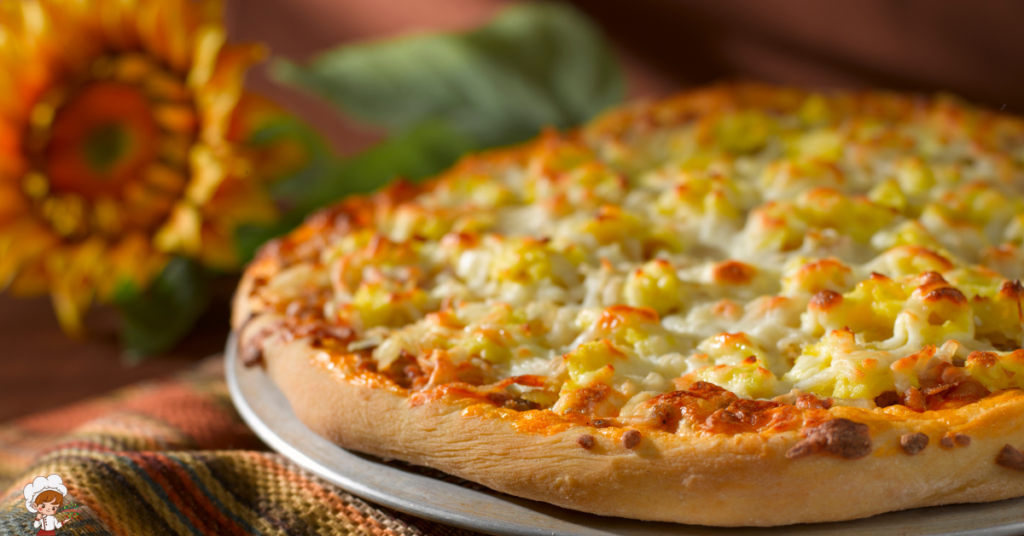How The Breakfast Pizza Rose To The Top

A Culinary Mashup
How The Breakfast Pizza Rose To The Top, a delightful fusion of morning staples and pizza, represents the ultimate blend of convenience, flavor, and creativity. This relatively modern creation has taken the culinary world by storm, offering an innovative twist on traditional breakfast foods by combining them with the universally loved pizza format. But how did this unique dish come to be, and what factors contributed to its rise in popularity? To understand the journey of breakfast pizza, we need to explore its roots, the evolution of breakfast foods, and the cultural shifts that led to its widespread appeal.
The Origins of Pizza: A Brief Overview
Before delving into the specifics of breakfast pizza, it’s essential to understand the origins of pizza itself. Pizza, in its most recognizable form, originated in Naples, Italy, in the late 18th century. This simple yet flavorful dish consisted of a flatbread topped with tomatoes, cheese, and various other ingredients. The Margherita pizza, named after Queen Margherita of Savoy, is one of the earliest and most iconic examples of traditional pizza, featuring the colors of the Italian flag: red (tomatoes), white (mozzarella cheese), and green (basil).
Pizza’s journey from a local Neapolitan dish to a global culinary phenomenon began in the late 19th and early 20th centuries, as Italian immigrants brought their pizza-making traditions to the United States. By the mid-20th century, pizza had become a staple of American cuisine, with regional variations and innovations emerging across the country. The stage was set for the creation of new and inventive forms of pizza, including the now-popular breakfast pizza.
The Evolution of Breakfast Foods: Setting the Stage
Breakfast, traditionally considered the most important meal of the day, has evolved significantly over the centuries. In ancient times, breakfast was often a simple, utilitarian meal designed to provide energy for the day’s labor. The foods consumed varied depending on the region and available ingredients. For instance, in ancient Rome, breakfast might consist of bread, olives, cheese, and fruit, while in medieval Europe, people commonly ate porridge, bread, and ale in the morning.
The concept of a standardized breakfast as we know it today began to take shape in the 19th century. The Industrial Revolution, urbanization, and the rise of the middle class contributed to the development of more structured mealtimes, including breakfast. In England, the full English breakfast—consisting of eggs, bacon, sausages, tomatoes, mushrooms, beans, and toast—became a symbol of prosperity and hospitality. Meanwhile, in the United States, breakfast cereals were invented as a convenient and healthful option for the increasingly busy lifestyles of the American population.
As the 20th century progressed, breakfast foods became more diverse and tailored to individual preferences. Pancakes, waffles, bagels, and pastries joined the ranks of popular breakfast items, alongside the ever-present eggs, bacon, and toast. The convenience of breakfast foods also became a significant factor, with the rise of ready-to-eat cereals, frozen waffles, and breakfast sandwiches catering to the needs of people on the go. This environment of culinary creativity and convenience set the stage for the emergence of breakfast pizza.
The Birth of Breakfast Pizza: An American Innovation
The exact origins of breakfast pizza are somewhat difficult to pinpoint, as it appears to have developed organically in various regions of the United States over the past few decades. However, the concept likely emerged in the late 20th century, inspired by the growing popularity of pizza as a versatile and customizable dish.
One possible precursor to breakfast pizza is the breakfast sandwich, which gained popularity in the United States in the 1970s and 1980s. Fast-food chains like McDonald’s introduced breakfast sandwiches such as the Egg McMuffin, which featured eggs, cheese, and Canadian bacon on an English muffin. These sandwiches were designed to be portable, convenient, and satisfying—a combination of qualities that would later influence the development of breakfast pizza.
Around the same time, pizzerias and home cooks began experimenting with non-traditional pizza toppings, including breakfast ingredients like eggs, bacon, sausage, and cheese. This experimentation eventually led to the creation of breakfast-themed pizzas, which offered a new and exciting way to enjoy familiar morning flavors in the beloved pizza format.

Breakfast Pizza Recipe
Ingredients
- Ingredients:
- For the Dough:
- 1 cup warm water about 110°F
- 1 packet 2 1/4 teaspoons active dry yeast
- 1 teaspoon sugar
- 2 1/2 cups all-purpose flour plus more for dusting
- 1 teaspoon salt
- 1 tablespoon olive oil
- For the Toppings:
- 4 large eggs
- 1/2 cup shredded mozzarella cheese
- 1/2 cup shredded cheddar cheese
- 4 slices bacon cooked and crumbled
- 1/2 cup cooked breakfast sausage crumbled
- 1/4 cup diced bell peppers
- 1/4 cup chopped green onions
- Salt and pepper to taste
- Optional: hot sauce fresh herbs (like parsley or chives), and avocado slices for garnish
Instructions
- Instructions:
- Prepare the Dough:
- In a small bowl, combine warm water, yeast, and sugar. Stir to dissolve and let sit for about 5 minutes, until the mixture becomes frothy.
- In a large mixing bowl, combine flour and salt. Create a well in the center and pour in the yeast mixture and olive oil. Stir until a dough forms.
- Transfer the dough to a lightly floured surface and knead for about 5-7 minutes, until the dough is smooth and elastic.
- Place the dough in a lightly oiled bowl, cover with a damp cloth, and let it rise in a warm place for about 1 hour, or until it has doubled in size.
- Preheat the Oven:
- Preheat your oven to 475°F (245°C). If you have a pizza stone, place it in the oven while it heats.
- Shape the Dough:
- Once the dough has risen, punch it down and transfer it to a floured surface. Roll it out into a 12-inch circle or a rectangle, depending on your preference.
- Transfer the rolled-out dough to a pizza peel or a baking sheet lined with parchment paper.
- Add the Toppings:
- Sprinkle the mozzarella and cheddar cheese evenly over the dough, leaving a small border around the edges.
- Crack the eggs directly onto the pizza, spacing them out evenly. Alternatively, you can scramble the eggs in a bowl and pour them over the pizza if you prefer scrambled eggs.
- Sprinkle the cooked bacon, sausage, bell peppers, and green onions over the cheese and eggs.
- Season with salt and pepper to taste.
- Bake the Pizza:
- Carefully slide the pizza onto the preheated pizza stone or place the baking sheet in the oven.
- Bake for 10-12 minutes, or until the crust is golden brown, the cheese is melted, and the eggs are cooked to your desired doneness.
- Serve:
- Remove the pizza from the oven and let it cool for a few minutes before slicing.
- Optional: Drizzle with hot sauce, sprinkle with fresh herbs, and add avocado slices if desired.
- Serve the breakfast pizza hot and enjoy!
The Rise in Popularity: Breakfast Pizza Goes Mainstream
The rise in popularity of breakfast pizza can be attributed to several key factors, including cultural shifts, changing dining habits, and the influence of social media.
- 1. The Brunch Boom:
The emergence of brunch as a popular dining trend in the late 20th and early 21st centuries played a significant role in the rise of breakfast pizza. Brunch, a meal that combines breakfast and lunch, became a social event and a platform for culinary creativity. Restaurants and cafes began offering elaborate and indulgent brunch menus, featuring dishes that blurred the lines between breakfast and lunch. Breakfast pizza, with its combination of traditional morning ingredients and pizza, fit perfectly into this trend.
Brunch-goers, especially millennials, embraced the idea of enjoying a savory, satisfying meal that combined the best of both worlds. The customizable nature of breakfast pizza also allowed for a wide range of variations, from classic combinations like eggs and bacon to more adventurous options featuring smoked salmon, avocado, or arugula.
2. The Convenience Factor:
In an increasingly fast-paced world, convenience has become a top priority for many consumers. Breakfast pizza offers the best of both worlds—it’s quick and easy to prepare, yet hearty and filling. Whether made at home or ordered from a restaurant, breakfast pizza provides a satisfying meal that can be enjoyed on the go or shared with family and friends.
Frozen breakfast pizzas, available in grocery stores, have also contributed to the dish’s popularity. Brands like DiGiorno, Red Baron, and Amy’s Kitchen offer frozen breakfast pizzas that can be quickly heated up for a convenient morning meal. This accessibility has made breakfast pizza a staple in many households, appealing to busy individuals and families looking for a quick and delicious breakfast option.
3. The Rise of Food Culture and Social Media:
In the age of Instagram and food blogs, visually appealing and creative dishes have the potential to go viral, and breakfast pizza is no exception. The colorful, mouthwatering appearance of a well-made breakfast pizza—often topped with perfectly cooked eggs, vibrant vegetables, and melty cheese—makes it a favorite subject for food photographers and social media influencers.
Food culture, driven by platforms like Instagram, Pinterest, and TikTok, has amplified the popularity of breakfast pizza by showcasing its versatility and aesthetic appeal. As more people share their own versions of breakfast pizza online, the dish continues to gain traction and inspire new culinary innovations.
4. The Health-Conscious Movement:
As health and wellness became a growing concern for consumers, the food industry responded with healthier options and alternatives. Breakfast pizza, which can be easily adapted to fit various dietary preferences and restrictions, has benefited from this trend. Whole-grain crusts, plant-based proteins, and an abundance of fresh vegetables are just a few of the ways breakfast pizza has been tailored to meet the demands of health-conscious eaters.
In addition to traditional breakfast pizzas, which often feature eggs, cheese, and meat, there has been a rise in vegetarian, vegan, and gluten-free breakfast pizza options. These variations cater to a broader audience and reflect the growing demand for healthier, more inclusive food choices.
5. The Creative Appeal:
One of the most significant factors contributing to the popularity of breakfast pizza is its inherent creativity. Breakfast pizza is a blank canvas that allows for endless experimentation and personalization. From the choice of crust to the variety of toppings, breakfast pizza can be adapted to suit individual tastes, dietary needs, and cultural influences.
This creativity extends to both home cooks and professional chefs, who have embraced breakfast pizza as a way to showcase their culinary skills and imagination. Whether it’s a simple homemade breakfast pizza topped with scrambled eggs and cheese or a gourmet version featuring smoked salmon, crème fraîche, and dill, breakfast pizza offers something for everyone.
Regional Variations: A National Phenomenon
As breakfast pizza gained popularity across the United States, regional variations began to emerge, each reflecting the unique culinary traditions and preferences of different areas.
1. New York: The Classic Breakfast Pizza
In New York, a city known for its pizza, breakfast pizza quickly became a popular option at pizzerias and brunch spots. The classic New York-style breakfast pizza often features a thin, crispy crust topped with scrambled eggs, bacon or sausage, and mozzarella or cheddar cheese. Some variations also include a drizzle of hot sauce or a sprinkle of chives for added flavor.
2. The South: Biscuits and Gravy Breakfast Pizza
In the Southern United States, where biscuits and gravy are a breakfast staple, it’s no surprise that this comforting dish found its way onto breakfast pizzas. Southern-style breakfast pizzas typically feature a biscuit crust topped with sausage gravy, scrambled eggs, and a generous helping of cheese. The result is a rich and hearty breakfast pizza that pays homage to the region’s culinary traditions.
3. The Midwest: Deep-Dish Breakfast Pizza
In the Midwest, known for its love of hearty, filling meals, deep-dish breakfast pizza has become a popular option. These pizzas are often baked in a cast-iron skillet, with a thick, buttery crust that can hold up to a substantial amount of toppings. Midwestern breakfast pizzas often feature eggs, cheese, sausage, and vegetables like peppers and onions, creating a satisfying and indulgent dish that’s perfect for a weekend brunch.
4. The West Coast: Healthy and Trendy Breakfast Pizzas
On the West Coast, where health-conscious and trendsetting food culture thrives, breakfast pizzas have taken on a lighter, more contemporary form. These pizzas often feature whole-grain or cauliflower crusts, an abundance of fresh vegetables, and toppings like avocado, smoked salmon, or arugula. West Coast breakfast pizzas reflect








